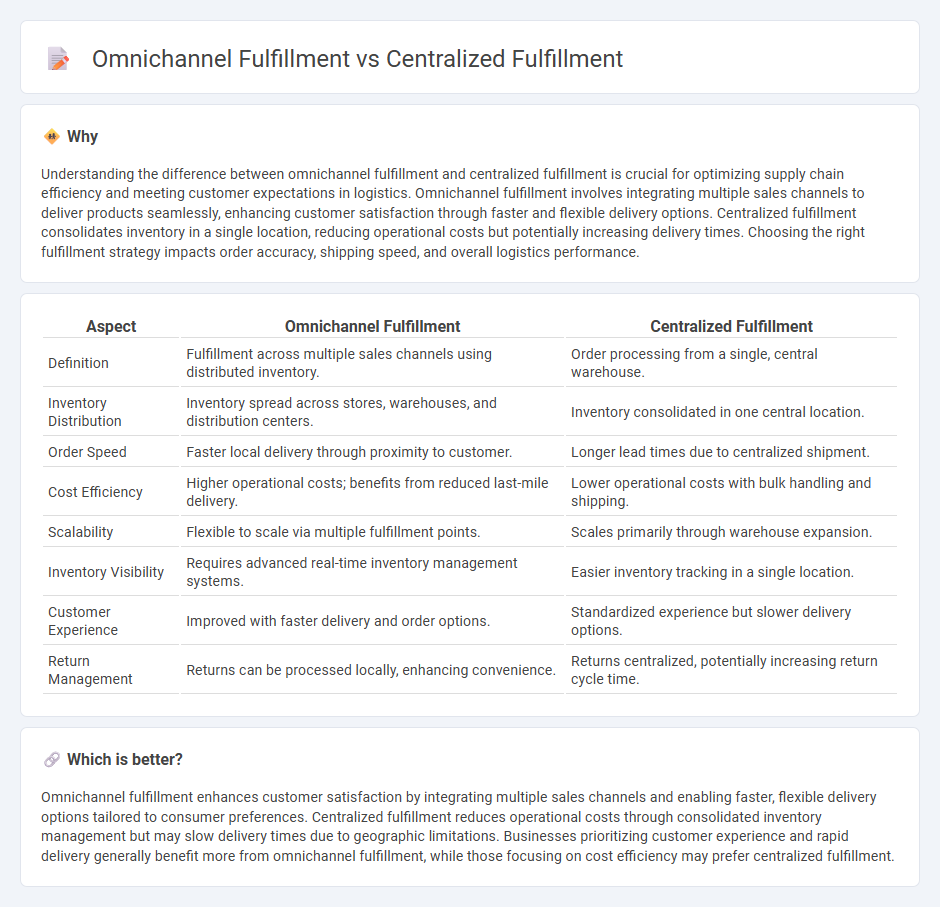
Omnichannel fulfillment integrates multiple sales channels to deliver a seamless customer experience, leveraging decentralized inventory and local distribution centers for faster delivery and greater flexibility. Centralized fulfillment concentrates inventory in a single location, optimizing operational efficiency and reducing overhead costs but often at the expense of delivery speed. Explore the differences between these strategies to optimize your supply chain management.
Why it is important
Understanding the difference between omnichannel fulfillment and centralized fulfillment is crucial for optimizing supply chain efficiency and meeting customer expectations in logistics. Omnichannel fulfillment involves integrating multiple sales channels to deliver products seamlessly, enhancing customer satisfaction through faster and flexible delivery options. Centralized fulfillment consolidates inventory in a single location, reducing operational costs but potentially increasing delivery times. Choosing the right fulfillment strategy impacts order accuracy, shipping speed, and overall logistics performance.
Comparison Table
| Aspect | Omnichannel Fulfillment | Centralized Fulfillment |
|---|---|---|
| Definition | Fulfillment across multiple sales channels using distributed inventory. | Order processing from a single, central warehouse. |
| Inventory Distribution | Inventory spread across stores, warehouses, and distribution centers. | Inventory consolidated in one central location. |
| Order Speed | Faster local delivery through proximity to customer. | Longer lead times due to centralized shipment. |
| Cost Efficiency | Higher operational costs; benefits from reduced last-mile delivery. | Lower operational costs with bulk handling and shipping. |
| Scalability | Flexible to scale via multiple fulfillment points. | Scales primarily through warehouse expansion. |
| Inventory Visibility | Requires advanced real-time inventory management systems. | Easier inventory tracking in a single location. |
| Customer Experience | Improved with faster delivery and order options. | Standardized experience but slower delivery options. |
| Return Management | Returns can be processed locally, enhancing convenience. | Returns centralized, potentially increasing return cycle time. |
Which is better?
Omnichannel fulfillment enhances customer satisfaction by integrating multiple sales channels and enabling faster, flexible delivery options tailored to consumer preferences. Centralized fulfillment reduces operational costs through consolidated inventory management but may slow delivery times due to geographic limitations. Businesses prioritizing customer experience and rapid delivery generally benefit more from omnichannel fulfillment, while those focusing on cost efficiency may prefer centralized fulfillment.
Connection
Omnichannel fulfillment relies on centralized fulfillment centers to efficiently manage inventory and streamline order processing across multiple sales channels. Centralized fulfillment enables real-time inventory visibility and reduces shipping costs by consolidating orders, enhancing customer satisfaction through faster delivery. This integration supports seamless coordination between online, in-store, and third-party sales platforms, optimizing supply chain performance.
Key Terms
Inventory Management
Centralized fulfillment consolidates inventory in a single warehouse, streamlining stock management and reducing overhead costs but potentially increasing delivery times to distant customers. Omnichannel fulfillment leverages inventory distributed across multiple locations, including stores and warehouses, enhancing order flexibility and customer satisfaction through faster, localized shipping. Explore the benefits and challenges of each approach to optimize your inventory management strategy.
Distribution Network
Centralized fulfillment consolidates inventory in a single distribution center, optimizing storage costs but potentially increasing shipping times and last-mile expenses. Omnichannel fulfillment leverages multiple distribution points, including stores and micro-fulfillment centers, to enhance delivery speed and customer convenience by reducing transit distances. Explore deeper insights into how distribution networks impact operational efficiency and customer satisfaction.
Customer Experience
Centralized fulfillment consolidates inventory in a single location, streamlining order processing but possibly slowing delivery times and reducing flexibility in customer service. Omnichannel fulfillment integrates various sales channels, offering faster shipments, enhanced order visibility, and personalized customer experiences across online and offline touchpoints. Explore how adopting omnichannel strategies can significantly elevate your customer satisfaction and loyalty.
Source and External Links
The Benefits of Centralized Fulfillment Centers for E-commerce - Discusses how centralized fulfillment centers streamline e-commerce operations, enhancing inventory management and customer satisfaction.
Centralized or Decentralized Fulfillment? - Explores the advantages of centralized fulfillment, including simplified inventory management and operational costs, compared to decentralized models.
How Centralized Fulfillment is Making Pharmacy More Efficient - Details how centralized fulfillment solutions improve pharmacy operations by leveraging automation and addressing staffing challenges.
 dowidth.com
dowidth.com